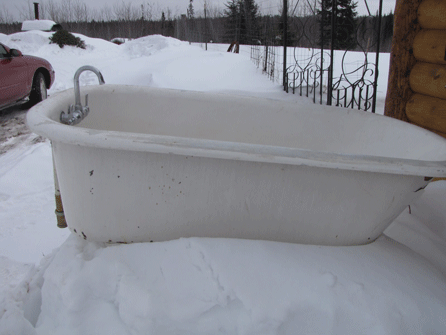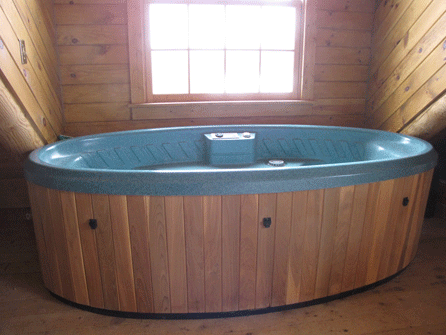No, we aren’t so tough here that we take baths outside in a snowdrift. David and Will just carried our VERY heavy, old, cast iron bathtub down 14 stairs and set it outside in preparation to carrying our new-used two-person hot tub, which is even heavier (and hard to hold onto) upstairs.
Both Will and I had bad backs before falling off the barn roof last summer and we really, really missed sitting in deep, hot water this winter! So when I found this inexpensive two-person used hot tub on Craigslist, we quickly took a drive 75 miles north, to International Falls.
It was a hard job, carrying that tub upstairs, on its side (only way it would fit up the stairs), but it’s up there and today Will is plumbing it into the drain and water line. Oh, my back can hardly wait for deep hot water!
It may not be hard-core homesteading, but it will sure keep these old homesteaders going.
Readers’ Questions:
Old dried beans
It seemed like a good idea at the time (I stored up about 400 pounds of pinto beans (50lb bags) about 5 or 6 years ago. Now I decided to start using them, and rotating my stock. Batch one, soaked for 5 days, changing water often, crock pot for 48 hours — beans still hard, smell bad, and taste bitter. Batch two, soaked over night, pressure cooked for 3 hours — beans still hard, and taste bitter. I am assuming my “investment” has gone bad. Is there any thing I can do with these old beans? Can they go into the garden whole or soaked first and whole or composted? I think I will be buying less and canning them immediately in the future.
Nanci Larkin
Westcliffe, Colorado
I sure wouldn’t compost my old beans! I routinely rotate my “old” pintos (which are up to 12 years old!) by canning them up for refried beans. They always come out tender and good tasting. One possibility though, with yours: is there any chance that they got musty or absorbed odors from storage?
Otherwise, what I do is to pick through my beans, discarding any bad ones or very dark beans as well as debris and rocks. Then I bring them to a boil in plenty of hot water, boil 2 minutes, then set them aside on the stove to soak without heat for 2 hours. (If you have city water, you might consider using filtered or bottled water as some city water has chemicals in it that DO make dry beans bitter.) Drain and discard the water. Again cover with fresh water, bring to a boil, adding any spices (garlic, onion, chile powder if you wish). Drain, reserving liquid. Pack beans 3/4 full into pint canning jars. Add small pieces of fried lean bacon or ham, if desired. Fill with hot cooking liquid, leaving 1 inch of headspace. Wipe rim of jar clean; place hot, previously-simmered lid on jar and screw down ring firmly tight. Process pints for 65 minutes and quarts for 75 minutes at 10 pounds pressure in a pressure canner.
You also may consider adding a generous pinch of baking soda to your initial boiling water, as you have already had bitter beans. This reduces any bitterness and also gas later on in most cases. — Jackie
Asparagus
I would like to plant more asparagus. I have an area of garden that isn’t fenced in. I let my chickens free range. They do NOT bother the other asparagus patch I have when the stalks are tall. Will the chickens pick at the asparagus as it comes out of the ground? I would like to avoid fencing if I can.
What did you sow in your orchard for “grass?” I have several areas that I would like to strengthen the soil and provide extra greens for the chickens. I would like to cut the “greens” too and dry it and save for winter.
I am glad you had a picture of your chickens and the turkeys. I was going to ask one of these times what happened to that family of turkeys that you had fenced in last summer. Why do you think that your turkeys don’t get sick living with the chickens?
I am most grateful for your advice and for all the canned goods and meat that we have. My husband had a high fasting blood at his last doctor’s appointment and mine is above what it should be too. We have cut down on sweets but eat more of our canned veggies, fruits and meats and the sugar counts are down. Thank God. I would also add how much better we are feeling too. So home grown food does improve your health! Yes, it’s work in the spring, summer, and fall but that’s worth the trouble for good food and the additional exercise gardening provides!
Cindy Hills
Wild Rose, Wisconsin
Yes, unfortunately, chickens will pick baby asparagus spears as it’s often one of the first, tender green things available. Often you can just run a 2-foot-high piece of chicken wire around your asparagus bed so you don’t have permanent fencing to deal with. You can step over it to harvest and remove it later on when you are through harvesting for the year.
We planted clover in our orchard. It keeps down the weeds, is easy to mow when it gets too tall (we do cut lots for the goats!) and the chickens and turkeys sure love to eat it! The clover also attracts bees so that helps pollinate our fruit trees.
Experts tell us that you’re not supposed to have chickens and turkeys together because the turkeys can get blackhead from the chickens. To tell the truth, I’ve never even seen a case of blackhead in either, and I was a veterinary technician for more than 25 years…along with always having plenty of poultry. Maybe in tight, commercial conditions this is a problem…or maybe just in some areas it is. I don’t know. All I do know is that our birds have plenty of free roaming space, plenty of good food, and remain totally healthy. We are looking forward to hatching our own chicken and turkey eggs this spring (we ended up with 3 hen turkeys from our babies last summer, plus we still have the two adult hens, so we should get plenty of eggs!). — Jackie
Storing cereal and granola bars
I’m just starting out with my food storage journey and was wondering if I can vacuum pack (with a Food Saver) things like cereals and granola bars. Will they stay fresh for a longer time? Or is it a waste of time?
Carolyn
Lothian, Maryland
I don’t think you’d be saving that much, as long as you keep your cereals and bars in the original bags/boxes. Granola bars, because they have oil in them, tend to get rancid faster than any cereals do. Better to store granola-bar ingredients separately and make up new ones as you need them. — Jackie
Hens eating their eggs and not laying as much
We have a small 5 hen flock of chickens that we dearly love. Recently, two issues have come up.
First, several months ago they started to eat their eggs. The oldest hens are two years old, and when we added a few new chicks (4 turned out to be roosters and we gave them away) the newbies began eating the eggs. Now all the hens will eat the eggs.
Second, egg production was stable at 3 eggs per day total (even with the occasional egg being eaten). Now it has dropped to 1 per day. I don’t see pieces of egg shell or yolk on the eggs we are collecting like I used to, so I don’t think the hens have started eating more of the eggs. Do you have any suggestions for us?
Carl and Evelyn
Columbus, North Carolina
I wouldn’t be too concerned. First of all, chickens molt twice a year and after that, it’s some time before they start laying eggs again. As spring approaches, you’ll suddenly see a surge of eggs again. To stop the egg eating, make sure your nest boxes are thickly bedded with shavings of straw to avoid accidental breakage. Pick the eggs often during the daytime. Try ceramic nest eggs. Not only do they encourage laying, but they also discourage egg eating. If these fail, build roll-out nests with floors sloping to the back and a shallow, out-of-the-way tray. Use minimal bedding so the eggs will roll and cushion the tray with shavings. Also, it helps to give your girls leafy hay and food scraps from the house to occupy their time. — Jackie
Chicken plucker
I was wondering if you have any plans or information for a chicken plucker?
Nicole Clark
Canton, North Carolina
We’ve been talking about making one soon. Meanwhile, check out the site www.backyardchickens.com for a simple, drill mounted CHEAP plucker that works. For more chickens you might want to make a whizbang chicken plucker (tub style). Photos are seen on http://achornfarm.blogspot.com/2009/06/how-to-build-chicken-plucker_30.html — Jackie
Cooking soup bones for stock
How do you use your soup bones for stock? I just had a beef slaughtered as well, but I am unsure what I need to do.
Rachel Murphy
Goddard, Kansas
Fill a large stock pot 2/3 full with water. Add about 8 pounds of meaty bones or more with less meat. Cut any rib bones into pieces about four inches long. Add two or three chopped onions, 2 bay leaves and 2 Tbsp. celery seed (optional). I also add black pepper and salt to taste after the stock has simmered 3 hours or more. If not “beefy” enough in flavor after this time, you may add beef bouillon cubes or granules, as well as the salt and pepper to taste.
Remove bones, then strain the broth into another pot. I cool my broth, then remove the excess fat, which hardens. Put the broth back on the stove to bring to simmering. It is now ready to can up — pints 20 minutes and quarts 25 minutes at 10 pounds pressure. — Jackie
Determining which hens are laying
How can I determine which hens are laying and which aren’t without separating them one by one? Someone told me there is a way to check them.
Dale Mellott
Martinsburg, Pennsylvania
Generally, the hens that are laying are wide between the legs, have a moist, shiny vent, and have red, healthy looking combs and wattles. The non-egg layers are usually narrow between the legs, have a dry vent, and pale combs and wattles. Remember, though, that there are no absolutes in this! — Jackie





Congrats on getting the hottub! YOU deserve it!
Love the hot tub, you all deserve it so very much! Your homestead is shaping up into such a wonderful, beautiful place. What an inspiration to all those who think they have to get everything right away, you show what patience, work and perseverance can get.
You can tell if a hen is laying just by sticking your fingers just below their anus. There are pelvic bones that move open when they are laying and close when they are not. If you can stick 2 or more fingers flat in between those bones then laying if one finger then laying in about 3 months or so for pullets. Just thought you would like to know. Love your web sight —heather
Jackie,
This is the second time you have helped us with one of our questions. Thank you so much for sharing your wisdom and for your commitment to this blog. You are a wonder!
Carl and Evelyn
Comments are closed.